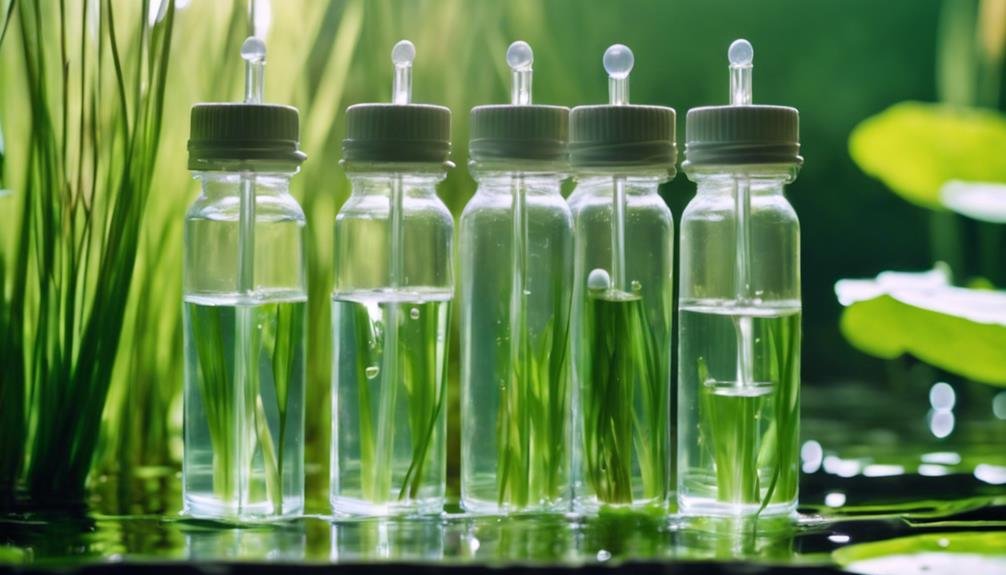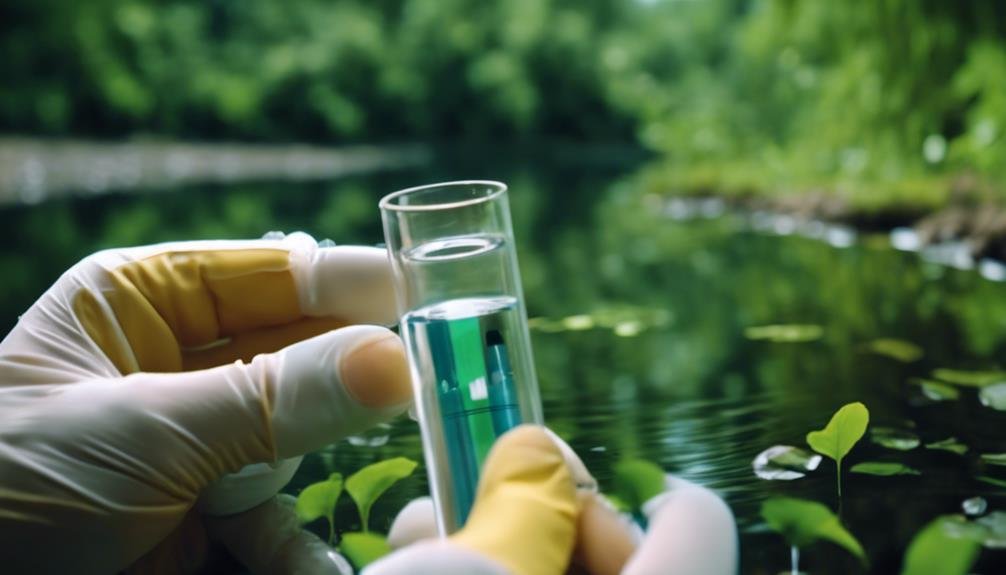Sustainable practices for testing pond water are essential for preserving aquatic ecosystems. You'll need to use eco-friendly sample collection techniques, such as clean, sterile bottles and proper labeling. Non-toxic testing equipment guarantees accurate results without harming the environment. Establish a regular monitoring schedule and calibrate your equipment frequently. Digital monitoring systems can provide real-time insights into water quality parameters. Proper data management and analysis help you track changes over time and make informed decisions. By following these practices, you'll maintain pond health while minimizing environmental impact. Exploring these methods further will enhance your understanding of sustainable pond management.
Importance of Sustainable Testing Methods
When it comes to testing pond water, you can't overlook the importance of sustainable methods that'll protect the ecosystem while giving you accurate results. Sustainable testing practices are essential for effective pond management, ensuring you maintain water quality without harming aquatic life. By using non-toxic testing kits, you'll reduce the risk of polluting your pond and disrupting its delicate balance.
These eco-friendly methods allow you to monitor essential parameters like oxygen levels, pH, and nutrient content without introducing harmful chemicals. This approach is particularly significant when managing algae growth, as it helps you address issues without negatively impacting beneficial organisms. Sustainable testing also supports long-term pond health by minimizing human interference in the ecosystem.
As a pond owner, choosing sustainable testing options contributes to the preservation of natural habitats and wildlife. These methods focus on obtaining important data while reducing your environmental footprint. By adopting such practices, you'll be able to accurately assess your pond's condition, make informed management decisions, and promote a thriving aquatic environment.
Eco-Friendly Sample Collection Techniques
Your pond's health relies on eco-friendly sample collection techniques that will guarantee accurate testing without disturbing the ecosystem. When conducting pond water testing, it's essential to use clean, sterile bottles to avoid contamination. Before collecting your sample, rinse the bottle three times with pond water to prevent cross-contamination and assure accurate results. Don't forget to wear gloves during the process to protect the sample from skin oils and bacteria.
Here are some key points to remember for eco-friendly sample collection:
- Use clean, sterile bottles for collection
- Rinse sample bottles three times with pond water
- Wear gloves to prevent contamination
- Store samples in a cooler with ice packs during transport
Proper labeling is vital for tracking your data accurately. Always include the date, time, and location on each sample bottle. This information will help you maintain reliable results and monitor changes in your pond's water quality over time.
Non-Toxic Testing Equipment

Three key factors make non-toxic testing equipment essential for responsible pond water analysis: safety, accuracy, and environmental preservation.
When you're testing your pond water, it's important to use equipment that won't harm the delicate ecosystem you're trying to maintain. Non-toxic testing equipment guarantees minimal impact on pond ecosystems while providing reliable results.
These testing kits use safe reagents that don't harm aquatic life, allowing you to gather accurate data without compromising the health of your pond. You'll find various options available, including test strips, liquid reagents, and digital meters.
Each of these tools offers a non-toxic approach to water analysis, supporting sustainable pond management practices.
Regular Monitoring and Calibration
Regular monitoring and calibration form the backbone of effective pond water management, ensuring you're always on top of your water quality. By consistently checking your pond water parameters, you'll be able to detect any issues early on, allowing for timely interventions.
Calibration of your testing equipment is essential for obtaining accurate and reliable results, which are vital for making informed decisions about your pond's health.
Implementing sustainable practices for pond water testing involves:
- Establishing a regular monitoring schedule
- Properly maintaining and calibrating testing equipment
- Keeping detailed records of test results
- Analyzing trends in water quality over time
Digital Monitoring Systems
Embracing cutting-edge technology, digital monitoring systems have revolutionized pond water testing, offering real-time insights into essential water quality parameters. These advanced systems provide you with continuous data on vital factors such as pH levels, dissolved oxygen, and temperature. By implementing digital monitoring systems, you'll have access to a wealth of information at your fingertips, allowing for immediate response to any water quality issues that may arise.
One of the key advantages of these systems is their ability to enable remote access to data. You can monitor your pond's water quality from anywhere, ensuring you're always informed about its condition. This feature is particularly valuable for early detection of problems, empowering you to adopt proactive management strategies before issues escalate.
Data Management and Analysis
While digital monitoring systems provide a wealth of real-time data, effective data management and analysis are essential to maximizing the full potential of your pond water testing efforts. By carefully recording and organizing test results for various water quality parameters, you'll be able to track changes over time and identify important trends.
This data management approach allows you to compare current test results with baseline data, enabling better diagnosis of potential issues.
To implement sustainable practices and maintain a healthy pond ecosystem, you'll need to focus on:
- Consistently recording pH, ammonia, nitrite, and other water quality parameters
- Analyzing collected data to identify patterns and potential problems
- Comparing current results with historical data to spot deviations
- Using data-driven insights to make informed decisions about pond maintenance
Preserving Pond Ecosystems

To safeguard your pond's long-term health and vitality, you'll need to adopt sustainable testing practices that preserve the delicate ecosystem balance. By implementing eco-friendly testing methods, you can maintain pond water quality while minimizing environmental impact. These sustainable solutions help protect aquatic life and contribute to a thriving ecosystem.
Regular testing is essential for early detection of potential issues, allowing you to take prompt corrective actions. As a pond owner, you're responsible for ensuring the health of your pond's ecosystem. By prioritizing sustainable testing practices, you're actively contributing to the overall well-being of your pond.
Utilizing eco-friendly testing methods not only reduces your environmental footprint but also helps maintain water quality. These practices are designed to work in harmony with natural processes, ensuring that your testing activities don't disrupt the delicate balance of your pond ecosystem.
Frequently Asked Questions
How to Test the Water Quality of a Pond?
To test your pond's water quality, you'll need a test kit. Collect samples as instructed, measure pH, ammonia, nitrite, and oxygen levels. Use the provided charts to interpret results. Keep records and test regularly for accurate monitoring.
How Can I Make My Pond More Sustainable?
To make your pond more sustainable, you'll want to implement natural pest control, create vegetation buffers, and install an aeration system. Regularly test water quality and plan for long-term ecological balance. Minimize chemical use whenever possible.
What Should Pond Water Test Be?
You should test your pond water for pH, ammonia, nitrite, nitrate, dissolved oxygen, and water hardness. It's also important to check for phosphates, iron, and other metals. Regular testing helps you maintain a healthy aquatic environment.
What Are the Parameters for Pond Water Test?
Ah, you're a pond connoisseur now? Splendid! You'll want to test for pH, ammonia, nitrite, nitrate, dissolved oxygen, and water hardness. Don't forget phosphates, iron, copper, turbidity, temperature, alkalinity, and conductivity. It's a regular water party!
Conclusion
You've learned about sustainable practices for testing pond water, but have you considered their long-term impact?
By implementing eco-friendly collection techniques, using non-toxic equipment, and embracing digital monitoring systems, you're not just gathering data—you're preserving delicate ecosystems.
Regular calibration and effective data management guarantee accuracy and insights.
Remember, sustainable testing isn't just about the present; it's about safeguarding our water resources for future generations.
Your choices matter in maintaining healthy ponds.

